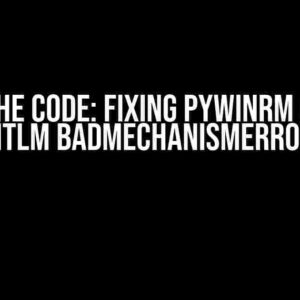Have you ever encountered an infinite loop when executing a merge statement using Pyodbc? You’re not alone! Many developers have stumbled upon this issue, and it’s essential to understand the root cause and solution to avoid frustrating hours of debugging. In this article, we’ll delve into the world of Pyodbc and merge statements, exploring the reasons behind this phenomenon and providing step-by-step guidance on how to overcome it.
What is Pyodbc?
Pyodbc is a Python extension that allows you to connect to ODBC-compatible databases, such as Microsoft SQL Server, Oracle, and PostgreSQL. It provides a convenient way to interact with databases using Python, making it a popular choice among developers. Pyodbc is built on top of the ODBC (Open Database Connectivity) API, which enables communication between applications and databases.
The Merge Statement Conundrum
A merge statement is a type of SQL statement that combines data from two sources into a single output. It’s commonly used for data integration, data warehousing, and data migration. In Pyodbc, when you execute a merge statement using the `cursor.execute()` method, you might expect the operation to complete successfully. However, in some cases, the merge statement can lead to an infinite loop, causing your program to hang or crash.
Why Does the Infinite Loop Occur?
The infinite loop occurs due to the way Pyodbc handles the merge statement. When you execute a merge statement, Pyodbc sends the SQL query to the database server, which processes the request and returns the results. However, if the merge statement is not properly constructed or if the database server encounters an error, the results might not be returned correctly. This can cause Pyodbc to enter an infinite loop, repeatedly sending the same query to the database server and waiting for a response that never arrives.
Symptoms of the Infinite Loop
If you’re experiencing an infinite loop with a merge statement in Pyodbc, you might observe the following symptoms:
- Your program hangs or freezes, consuming high CPU and memory resources.
- The database server logs show repeated executions of the same merge statement.
- Your application crashes or terminates unexpectedly.
Troubleshooting the Infinite Loop
To resolve the infinite loop issue, follow these steps:
-
Verify the merge statement: Review your merge statement to ensure it’s correctly constructed and valid. Check for syntax errors, invalid column names, and incorrect data types.
-
Check the database server logs: Analyze the database server logs to identify any errors or warnings related to the merge statement. This can help you pinpoint the root cause of the issue.
-
Use the `cursor.execute()` method with caution: Be careful when using the `cursor.execute()` method to execute the merge statement. Make sure to handle any exceptions and errors that might occur during execution.
-
Implement error handling and retries: Implement error handling and retry mechanisms to handle situations where the merge statement fails or enters an infinite loop. This can help prevent your program from crashing or hanging.
Error Handling and Retry Mechanisms
To prevent the infinite loop, it’s essential to implement error handling and retry mechanisms in your Pyodbc code. Here’s an example of how you can do this:
import pyodbc
# Establish a connection to the database
conn = pyodbc.connect('DRIVER={ODBC Driver 17 for SQL Server};SERVER=localhost;DATABASE=mydatabase;UID=myusername;PWD=mypassword')
# Create a cursor object
cursor = conn.cursor()
try:
# Execute the merge statement
cursor.execute("""
MERGE INTO mytable AS target
USING (SELECT * FROM mysource) AS source
ON target.id = source.id
WHEN MATCHED THEN
UPDATE SET target.column1 = source.column1,
target.column2 = source.column2
WHEN NOT MATCHED THEN
INSERT (column1, column2)
VALUES (source.column1, source.column2);
""")
# Commit the changes
conn.commit()
except pyodbc.Error as e:
# Handle the error
print(f"Error: {e}")
# Retry the merge statement up to 3 times
retry_count = 0
while retry_count < 3:
try:
# Execute the merge statement again
cursor.execute("""
MERGE INTO mytable AS target
USING (SELECT * FROM mysource) AS source
ON target.id = source.id
WHEN MATCHED THEN
UPDATE SET target.column1 = source.column1,
target.column2 = source.column2
WHEN NOT MATCHED THEN
INSERT (column1, column2)
VALUES (source.column1, source.column2);
""")
# Commit the changes
conn.commit()
# Break the loop if successful
break
except pyodbc.Error as e:
# Increment the retry count
retry_count += 1
# Wait for 1 second before retrying
time.sleep(1)
# Print the error message
print(f"Error: {e}. Retrying...")
Best Practices for Using Pyodbc with Merge Statements
To avoid infinite loops and ensure successful execution of merge statements with Pyodbc, follow these best practices:
| Best Practice | Description |
|---|---|
| Verify the merge statement | Ensure the merge statement is correctly constructed and valid. |
| Use error handling and retries | Implement error handling and retry mechanisms to handle situations where the merge statement fails or enters an infinite loop. |
| Monitor database server logs | Analyze the database server logs to identify any errors or warnings related to the merge statement. |
| Use transactions | Use transactions to ensure atomicity and consistency when executing merge statements. |
| Test and debug | Thoroughly test and debug your Pyodbc code to ensure it’s working correctly and efficiently. |
Conclusion
In this article, we’ve explored the issue of infinite loops when using Pyodbc with merge statements. We’ve discussed the reasons behind this phenomenon, symptoms, and troubleshooting steps to resolve the issue. By following best practices and implementing error handling and retry mechanisms, you can ensure successful execution of merge statements with Pyodbc and avoid infinite loops.
Remember, when working with Pyodbc and merge statements, it’s essential to be mindful of the potential pitfalls and take proactive measures to prevent infinite loops. By doing so, you can build robust and efficient data integration applications that meet your business requirements.
Have you encountered infinite loops with Pyodbc and merge statements? Share your experiences and solutions in the comments below!
Frequently Asked Question
Get answers to your burning questions about infinite loops and merge statements with pyodbc!
What is an infinite loop, and how does it occur with pyodbc?
An infinite loop occurs when a program or process repeats indefinitely, often consuming system resources. In the context of pyodbc, an infinite loop can occur when a merge statement is entered, causing the program to repeatedly execute without terminating. This can happen due to incorrect SQL syntax, improper database connection, or faulty logic in the Python script.
Why does the infinite loop occur specifically with merge statements in pyodbc?
Merge statements in pyodbc can lead to infinite loops because they involve inserting, updating, or deleting data based on specific conditions. If these conditions are not properly defined or are missing, the merge statement may repeatedly execute without termination, resulting in an infinite loop.
How can I identify an infinite loop caused by a merge statement in pyodbc?
To identify an infinite loop, look for symptoms such as high CPU usage, memory consumption, or endless repetition of SQL queries. You can also use debugging tools or logging mechanisms to track the execution of your Python script and pyodbc connections. Monitor your program’s behavior and check for any repeating patterns or errors.
What are some common causes of infinite loops with merge statements in pyodbc?
Common causes of infinite loops include incorrect SQL syntax, missing or incorrect WHERE clauses, faulty join conditions, and unexpected null or duplicate values. Additionally, issues with database connection, transaction handling, or cursor management can also contribute to infinite loops.
How can I prevent or fix infinite loops caused by merge statements in pyodbc?
To prevent or fix infinite loops, ensure correct SQL syntax, define clear and specific conditions in your merge statement, and handle potential errors and exceptions. Implement transaction management, cursor handling, and logging mechanisms to monitor and debug your program. Regularly test and validate your code to catch any potential issues before they escalate into infinite loops.






